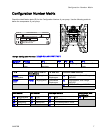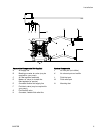
Installation
Ground The Sys
tem
The equipmen
t must be grounded to reduce the
risk of stati
c sparking. Static sparking can cause
fumes to igni
te or explode. Grounding provides an
escape wire f
or the electrical current.
• Always ground the entire fluid system as
described below.
• Polypropylene and PVDF pumps are not
conductive and are not for use with flammable
fluids.
• Follow your local fire codes.
Before operating the pump, ground the system as
explained below.
• Pump: Always ground the entire fluid system by
making sure the fluid has an electrical path to a
true earth ground.
• Air and fluid hoses: Use only grounded hoses
with a maximum of 500 ft (150 m) combined hose
length to ensure grounding continuity.
• Air compressor: Follow manufacturer’s
recommendations.
• Fluid supply container: Follow local code.
• Solvent pails used when flushing: Follow local
code. Use only conductive metal pails, placed
on a grounded surface. Do not place the pail
on a nonconductive surface, such as paper or
cardboard, which interrupts grounding continuity.
Check
your system electrical continuity after the
init
ial installation, and then set up a regular schedule
for c
hecking continuity to be sure proper grounding
is ma
intained.
Air Lines
1. Install an air
regulator and gauge (C) to control
the fluid press
ure. The fluid stall pressure will be
thesameasthe
setting of the air regulator.
2. Locate a bleed
-typemasterairvalve(B)closeto
the pump and u
se it to relieve trapped air. Be
sure the valv
e is easily accessible from the pump
and located d
ownstream from the regulator.
Trapped air can cause the pump to cycle
unexpectedly, which could result in serious
injury from splashing.
3. Locate another master air valve (D) upstream
from all air line accessories and use it to isolate
them during cleaning and repair.
4. An air line filter (C) removes harmful dirt and
moisture from the compressed air supply.
5. Install a grounded, flexible air hose (A) between
the accessories and the 3/4 npt(f) pump air inlet.
10 3A2578B


















